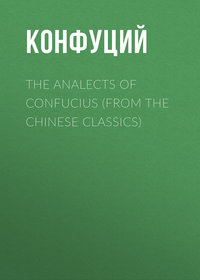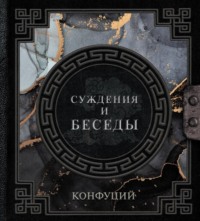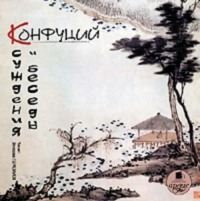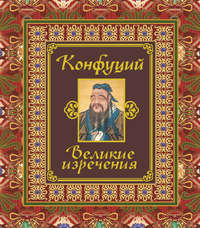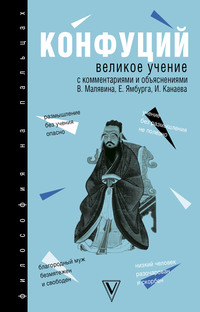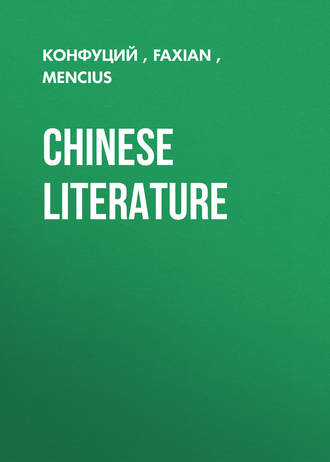 полная версия
полная версияChinese Literature
102
The Srotâpannas are the first class of saints, who are not to be reborn in a lower sphere, but attain to nirvŕna after having been reborn seven times consecutively as men or devas. The Chinese editions state there were one thousand of the Săkya seed. The general account is that they were five hundred, all maidens, who refused to take their place in king Vaidurya's harem, and were in consequence taken to a pond, and had their hands and feet cut off. There Buddha came to them, had their wounds dressed, and preached to them the Law. They died in the faith, and were reborn in the region of the four Great Kings. Thence they came back and visited Buddha at Jetavana in the night, and there they obtained the reward of Srotâpanna.
103
Fâ-hien does not say that he himself saw any of these white elephants, nor does he speak of the lions as of any particular color. We shall find by and by, in a note further on, that, to make them appear more terrible, they are spoken of as "black."
104
The bones of the human body are supposed to consist of 84,000 atoms, and hence the legend of Asoka's wish to build 84,000 topes, one over each atom of Sakyamuni's skeleton.
105
A Brahman of Benâres, said to have been one hundred and twenty years old, who came to learn from Buddha the very night he died. Ânanda would have repulsed him; but Buddha ordered him to be introduced; and then putting aside the ingenious but unimportant question which he propounded, preached to him the Law. The Brahman was converted and attained at once to Arhatship.
106
Âmbapâlî, Âmrapâlî, or Âmradarikâ, "the guardian of the Âmra (probably the mango) tree," is famous in Buddhist annals. She was a courtesan. She had been in many nârakas or hells, was one hundred thousand times a female beggar, and ten thousand times a prostitute; but maintaining perfect continence during the period of Kâsyana Buddha, Sakyamuni's predecessor, she had been born a devî, and finally appeared in earth under an Âmra tree in Vaisâlî. There again she fell into her old ways, and had a son by king Bimbisâra; but she was won over by Buddha to virtue and chastity, renounced the world, and attained to the state of an Arhat.
107
Thus Sâkyamuni had been one of the thousand little boys who floated in the box in the Ganges. How long back the former age was we cannot tell. I suppose the tope of the two fathers who became Pratyeka Buddhas had been built like the one commemorating the laying down of weapons after Buddha had told his disciples of the strange events in the past.
108
Bhadra-kalpa, "the Kalpa of worthies or sages." "This," says Eitel, "is a designation for a Kalpa of stability, so-called because one thousand Buddhas appear in the course of it. Our present period is a Bhadra-kalpa, and four Buddhas have already appeared. It is to last two hundred and thirty-six millions of years, but over one hundred and fifty-one millions have already elapsed."
109
"The king of demons." The name Mara is explained by "the murderer," "the destroyer of virtue," and similar appellations. "He is," says Eitel, "the personification of lust, the god of love, sin, and death, the arch-enemy of goodness, residing in the heaven Paranirmita Vasavartin on the top of the Kamadhatu. He assumes different forms, especially monstrous ones, to tempt or frighten the saints, or sends his daughters, or inspires wicked men like Devadatta or the Nirgranthas to do his work. He is often represented with 100 arms, and riding on an elephant."
110
Or the Vinaya-pitaka. The meeting referred to was an important one, and is generally spoken of as the second Great Council of the Buddhist Church. The first Council was that held at Râjagriha, shortly after Buddha's death, under the presidency of Kâsyapa—say about B.C. 410. The second was that spoken of here—say about B.C. 300.
111
He was the son of king Bimbisâra, who was one of the first royal converts to Buddhism. Ajasat murdered his father, or at least wrought his death; and was at first opposed to Sakyamuni, and a favorer of Devadotta. When converted, he became famous for his liberality in almsgiving.
112
"Samâdhi," says Eitel, "signifies the highest pitch of abstract, ecstatic meditation; a state of absolute indifference to all influences from within or without; a state of torpor of both the material and spiritual forces of vitality; a sort of terrestrial Nirvâna, consistently culminating in total destruction of life."
113
The modern Patna. The Sanscrit name means "The city of flowers." It is the Indian Florence.
114
One of the five first followers of Sakyamuni. He is also called Asvajit; in Pali Assaji; but Asvajit seems to be a military title, "Master or trainer of horses." The two more famous disciples met him, not to lead him, but to be directed by him, to Buddha.
115
A very great place in the annals of Buddhism. The Council in the Srataparna cave did not come together fortuitously, but appears to have been convoked by the older members to settle the rules and doctrines of the order. The cave was prepared for the occasion by king Ajâtasatru.
116
Buddha made a law forbidding the monks to commit suicide. He prohibited any one from discoursing on the miseries of life in such a manner as to cause desperation.
117
Called also Maha, or the Great Muchilinda. Eitel says"A naga king, the tutelary deity of a lake near which Sakyamuni once sat for seven days absorbed in meditation, whilst the king guarded him." The account in "The Life of the Buddha" is:—"Buddha went to where lived the naga king Muchilinda, and he, wishing to preserve him from the sun and rain, wrapped his body seven times round him, and spread out his hood over his head; and there he remained seven days in thought."
118
Yama was originally the Âryan god of the dead, living in a heaven above the world, the regent of the south; but Brahmanism transferred his abode to hell. Both views have been retained by Buddhism. The Yama of the text is the "regent of the narakas, residing south of Jambudvîpa, outside the Chakravâlas (the double circuit of mountains above), in a palace built of brass and iron. He has a sister who controls all the female culprits, as he exclusively deals with the male sex. Three times, however, in every twenty-four hours, a demon pours boiling copper into Yama's mouth, and squeezes it down his throat, causing him unspeakable pain." Such, however, is the wonderful "transrotation of births," that when Yama's sins have been expiated, he is to be reborn as Buddha, under the name of "The Universal King."
119
"The rishi," says Eitel, "is a man whose bodily frame has undergone a certain transformation by dint of meditation and asceticism, so that he is, for an indefinite period, exempt from decrepitude, age, and death. As this period is believed to extend far beyond the usual duration of human life, such persons are called, and popularly believed to be, immortals." Rishis are divided into various classes; and rishi-ism is spoken of as a seventh path of transrotation, and rishis are referred to as the seventh class of sentient beings.
120
This is the only instance in Fâ-hien's text where the Bodhisattva or Buddha is called by the surname "Gotama." For the most part our traveller uses Buddha as a proper name, though it properly means "The Enlightened." He uses also the combinations "Sâkya Buddha," which means "The Buddha of the Sâkya tribe," and "Sâkyamuni," which means "The Sâkya sage." This last is the most common designation of the Buddha in China. Among other Buddhistic peoples "Gotama" and "Gotama Buddha" are the more frequent designations.
121
Mahâsânghikâ simply means "the Great Assembly," that is, of monks.
122
It was afterwards translated by Fâ-hien into Chinese.
123
A gâtha is a stanza, generally consisting of a few, commonly of two, lines somewhat metrically arranged.
124
"A branch," says Eitel, "of the great vaibhâshika school, asserting the reality of all visible phenomena, and claiming the authority of Râhula."
125
This would be what is known as "Adam's peak," having, according to Hardy, the three names of Selesumano, Samastakűta, and Samanila. There is an indentation on the top of it, a superficial hollow, 5 feet 3 3/4 inches long, and 2 1/2 feet wide. The Hindus regard it as the footprint of Siva; the Mohammedans, as that of Adam; and the Buddhists, as in the text—as having been, made by Buddha.
126
We naturally suppose that the merchant-offerer was a Chinese, as indeed the Chinese texts say, and the fan such as Fâ-hien had seen and used in his native land.
127
A Kalpa, we have seen, denotes a great period of time; a period during which a physical universe is formed and destroyed. Asankhyeya denotes the highest sum for which a conventional term exists—according to Chinese calculations equal to one followed by seventeen ciphers; according to Thibetan and Singhalese, equal to one followed by ninety-seven ciphers. Every Maha-kalpa consists of four Asankhye-yakalpas.
128
That is, those whose Karma in the past should be rewarded by such conversion in the present.
129
What these vegetables exactly were it is difficult to say; and there are different readings of the characters for kwoh, brings the two names together in a phrase, but the rendering of it is simply "a soup of simples."
130
It is likely that these men were really hunters; and, when brought before Fâ-hien, because he was a Sramana, they thought they would please him by saying they were disciples of Buddha. But what had disciples of Buddha to do with hunting and taking life? They were caught in their own trap, and said they were looking for peaches.
131
Han Koong Tsew, literally "Autumn in the Palace of Han"; but in Chinese, Autumn is emblematic of Sorrow, as Spring is of Joy, and may therefore be rendered by what it represents.
132
In Chinese, Ko-ban.
133
The mother of Hoeyte, a bold and able woman, who ruled for her son, the second emperor of Han.
134
Boding a short but fatal distinction to her offspring.
135
Instead of glass, to defend it from the wind.
136
The principal taxes in China are the land-tax, customs, salt monopoly, and personal service; which last is the source of much oppression to the lowest orders, who have nothing but their labor to contribute.
137
The honor of the imperial alliance being the chief object.
138
Changngo, the goddess of the moon, gives her name to the finely curved eyebrows of the Chinese ladies, which are compared to the lunar crescent when only a day or two old.
139
Chow-wong was the last of the Shang dynasty, and infamous by his debaucheries and cruelties, in concert with his empress Takee, the Theodora of Chinese history.
140
The imperial pronoun "Tchin," me, is with very good taste supplied by I in these impassioned passages.
141
It may be observed that the great wall is never once expressly mentioned through this drama. The expression used is Pëensih, the border, or frontier. The wall had existed two hundred years at this time, but the real frontier was beyond it.
142
Or Saghalien, which falls into the sea of Ochotsk.
143
Said to exist now and to be green all the year.
144
There is nothing in this more extravagant than the similar vision in the tragedy of Richard III.
145
Yengo, a species of wild goose, is the emblem in China of intersexual attachment and fidelity, being said never to pair again after the loss of its mate. An image of it is worshipped by newly married couples.
146
Literally, "dragon person." The emperor's throne is often called the "dragon seat."





